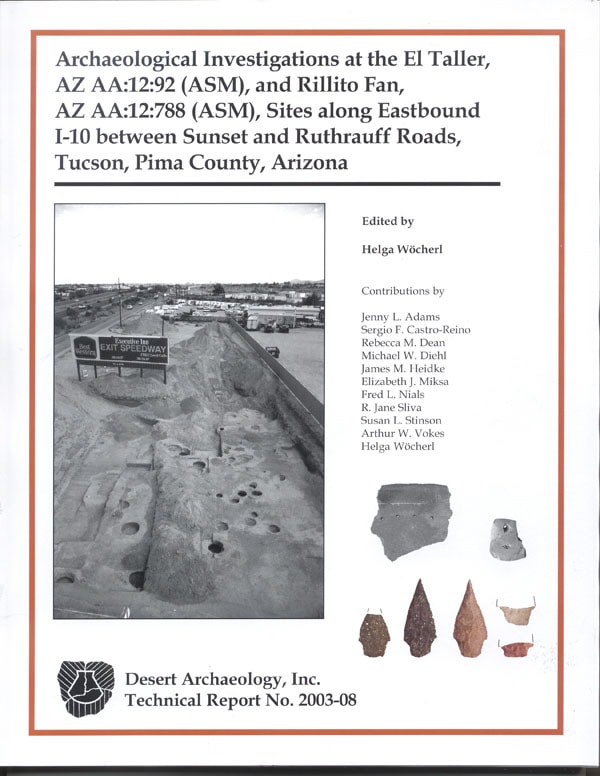Description
Archaeological Investigations at the El Taller, AZ AA:12:92 (ASM), and Rillito Fan, AZ AA:12:788 (ASM), Sites along Eastbound I-10 between Sunset and Ruthrauff Roads, Tucson, Pima County, Arizona (TR2003-08)
Edited by Helga Wocherl, with contributions by Jenny L. Adams, Sergio F. Castro-Reino, Rebecca M. Dean, Michael W. Diehl, James M. Heidke, Elizabeth J. Miksa, Fred L. Nials, R. Jane Sliva, Susan L. Stinson, Arthur W. Vokes, and Helga Wocherl.
194 pages, 53 figures, 68 tables..
Results of excavations at two sites between Sunset Road and Ruthrauff Road along Interstate 10 (I-10) are reported here. The work was conducted as part of the I-10 Frontage Roads Improvement Project for the Arizona Department of Transportation (ADOT). The site of El Taller, AZ AA:12:92 (ASM), contains three temporal components possibly dating as early as the Middle Archaic period to Hohokam times. The excavated portion of th eRilliot Fan site, AZ AA:12:788 (ASM), dates to the Classic period, with evidence of a Tucson phase (A.D. 1300-1450) presence. Previous work at the Rillito Fan site also uncovered occupations dating to the Middle Archaic and Early Agricultural periods (1200 B.C.-A.D. 50). Both project areas have been heavily disturbed by historic agricultural activities and modern road construction.
Both project areas represent unique research opportunities at nearly opposite ends of the temporal continuum of the prehistoric occupation in the Tucson Basin. El Taller contains a long sequence of pre- and early ceramic occupation and may have yielded the currently earliest radiocarbon date on cultivated maize in the southern Southwest. Although only a segment of a largely Early agricultural period site, the excavations at El Taller recovered features and materials that reflect the organization of prehistoric activities—such as projectile point and perhaps bone bead manufacture. The local production of identical Empire-style San Pedro phase projectile points indicates a knapper or group cognitive template and extended or repeated site use, with a possible functional or territorial aspect. The chosen site name, El Taller—the workshop—reflects that prehistoric behavior.
At Rillito Fan, the presence of Salado Polychrome ceramics places the investigated site portion into the late Classic period. The sizeable local production of Gila Polychrome and the presence of perforated plates, an originally northern ceramic form, along with a Tucson phase radiocarbon date, indicate a terminal Classic occupation. The additional presence of ceramic designs from the Colonial (A.D. 750-950) and Sedentary periods (A.D. 950-1150) show that this occupation grew from firm earlier roots. While contiguous room blocks and compound walls found at other late Classic period sites are absent from this portion of Rillito Fan, the presence of plaster in a well-made pit structure, large borrow pits, and numerous adobe puddling pits indicate that construction activities outside, but near, the project right-of-way must have been extensive. The grouping of present structures may reflect the social aspect of this physical site segment. As information and data from late Hohokam sequence are rare and often limited to non-systematic explorations and near-anecdotal reports, the findings at Rillito Fan represent a significant contribution.
